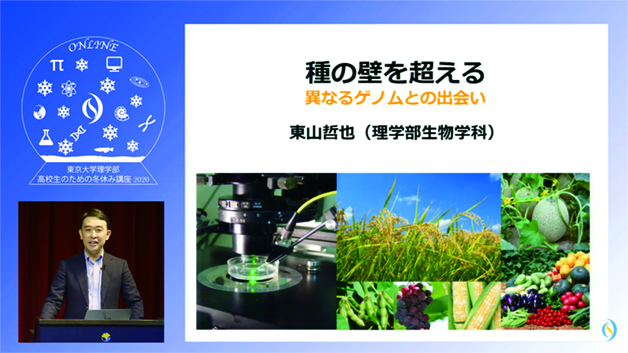Disclaimer: machine translated by DeepL which may contain errors.
The Power to Transcend
Tetsuya Higashiyama, Professor, Department of Biological Sciences
Bread wheat for making bread and ramen noodles, cotton for making cotton clothes, and rape seed for obtaining cooking oil and biodiesel: what do they all have in common? All of these plants were created by fertilization across species barriers. Plants have a high capacity to produce new species, called heteroploidy, through cross-species fertilization, which is one of the major driving forces in adaptive evolution and breeding. The crossing of different genomes can produce new traits that allow plants to move into new environments where their parents could not, or to innovate in agriculture.
To understand the ability of plants to transcend species barriers, researchers must also be able to transcend disciplinary barriers. Flowers, the birthplace of new species, are the organs that fertilize and produce seeds and fruits. It is difficult to study what happens inside the flower, and the behavior of the cells, the molecules that control fertilization, and the changes in gene expression networks that occur when the genomes of different species intersect have been shrouded in mystery. As various microscopy techniques have won Nobel Prizes, knowledge and techniques from different fields can bring breakthroughs in biology. In order to advance research on the birth of new species, the power of many different fields, such as chemistry, physics, informatics, and engineering, is required.
Since I was a graduate student, I have been studying plant fertilization under the motto "under the microscope at will. Under the policy of my laboratory that if we did not have the necessary equipment or methods, we would make them ourselves, I have promoted a "one-man fusion of different fields. The university is a creative place with easy access to a variety of information sources, including not only academic journals but also books and scientific equipment manufacturers. The free thinking, absorptive capacity, and time for immersion that characterize young students and post-doctoral researchers are also strengths that enable them to take on new challenges and achieve one-person interdisciplinary fusion. In my case, I was the first to capture plant fertilization on film, leading to the discovery of a pollen tube attractant that attracts pollen tubes to plant eggs, a process that has been explored for 140 years.
The discovery of the pollen tube attractant led to the experience of interdisciplinary research, which is something I could not have done on my own. I had the opportunity to meet specialists in nano-engineering and informatics in the same laboratory under one roof. He learned the fun of producing new results one after another, and even designed an entire building to establish a fusion research center for chemistry and biology with his contemporaries at Nagoya University, where he was formerly affiliated. Pollen tube attractants are also species-authenticating molecules that selectively or preferentially attract pollen tubes of the same species. In addition to pollen tube attractants, the discovery and molecular understanding of the group of molecules that work in the flower and are necessary to transcend the species barrier has advanced dramatically. The efforts of the fusion of different fields were a successful research project involving the principles of the birth of new plant species, which spread to researchers across the country.
However, he was far from satisfied with "freely under the microscope. Returning to the Department of Biological Sciences, where he spent his graduate school days, he is now working on the development of a microscope with the laboratory of Dr. Yasushi Okada of the Department of Physics, hoping to capture details inside cells that cannot be seen alive. I have been involved in many interdisciplinary fusion research projects, and I feel that the real thrill of such projects is the sense of excitement. We would like to provide an appropriate place for many students to experience this excitement by cultivating their ability to transcend the barriers between disciplines, while expanding their dreams for the new building as well.
 |
|||
| From Winter Break Lecture 2020 for High School Students | |||
Published in Faculty of Science News March 2022


